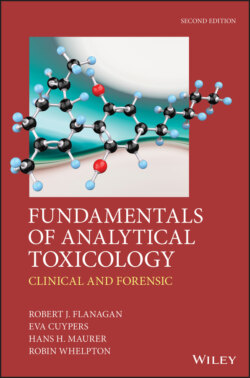Читать книгу Fundamentals of Analytical Toxicology - Robin Whelpton - Страница 18
1.2.1 Analytical methods
ОглавлениеImmunoassays have found wide application in analytical toxicology. A range of techniques, for example enzyme-multiplied immunoassay technique (EMIT) and cloned enzyme donor immunoassay (CEDIA), are available and are often highly sensitive. Enzyme-based assays, such as that for paracetamol (acetaminophen), have also been described. However, all of these assays have the disadvantage that antibodies, enzymes, or specific binding proteins have to be prepared for each analyte or group of analytes before an analysis is possible. On the other hand, these and similar assays may often be used directly in small volumes of aqueous media (‘homogenous assay’), in contrast to chromatographic methods, which often require some form of sample preparation procedure, for example liquid–liquid extraction (LLE), otherwise known as solvent extraction, prior to the analysis. Moreover, although immunoassays can be very sensitive, some may be poorly selective, the antibody recognizing several structurally similar molecules. Sometimes this cross-reactivity can be exploited, as in screening for classes of misused drugs such as benzodiazepines and opiates (Box 1.1).
There are practical considerations. Immunoassay is a batch process and therefore readily amenable to automation, whilst GC and LC involve sequential assays on the same instrument. Whilst automated sample preparation and shorter columns/faster analysis times can help, this remains a limiting factor. However, the infinitely greater selectivity of chromatographic methods even without MS detection means that such methods are often a prerequisite if the results are to withstand scrutiny in a court of law.
LC has achieved wide application in analytical toxicology since the 1970s. Gases and very volatile solvents excepted, many analytes are amenable to analysis by LC or a variant of the basic procedure. GC, on the other hand, is restricted to the analysis of either compounds or derivatives that are both stable and volatile at temperatures up to approximately 350 °C. This being said, GC with modern bonded-phase capillary columns, temperature programming, nitrogen–phosphorus detection (NPD), and MS detection either when used alone, or linked in series (MS/MS), has tremendous sensitivity and selectivity especially when combined with a selective sample preparation procedure.
The use of LC in the qualitative analysis of drugs and other poisons has been limited by the lack of a sensitive universal detector analogous to the flame ionization detector (FID) in GC and the poor performance of gradient elution systems. However, a range of sensitive MS detectors is now available for use with LC and together with modern narrow-bore packed columns and eluent gradient programming, major advances have been made. The advent of accurate mass detection systems, i.e. detectors that can measure mass-to-charge ratio (m/z) to four decimal places, together with other parameters that can be measured to increase the certainty of peak assignment, has been yet another milestone (Grapp et al., 2018). However, the high purchase and maintenance costs of such systems remains a major barrier to their widespread use.
